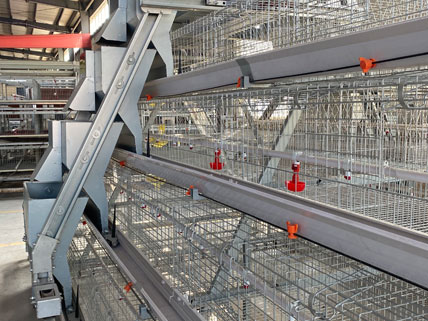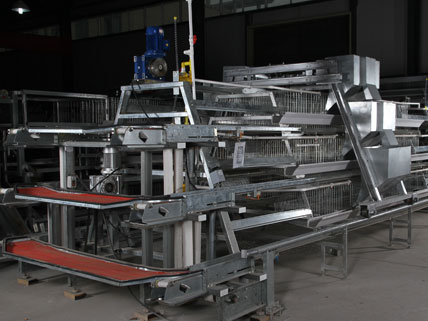Advantages Of Battery Cage System
What is a battery cage system?
Battery cage primarily refers to multi-layer layer cages while it also includes chick cages, broiler cages, etc. poultry cages. A battery cage system is a housing system practiced by farmers raising poultries in wire-welded cages. 1-5 cages are connected into a row and are stacked to 3-9 tiers which forms a set of chicken cages. Multiple sets of battery cages can be arranged in a chicken house with the aisle between each other.
Poultry farm equipment used in the battery cage system mainly includes the chicken cages, the automatic chicken feeding system, the poultry drinking system, the poultry manure removal system, and the climate control system.
In modern poultry farming, the battery cage system is widely used for its advantages in high dense stocking, the convenient epidemic prevention, the easy management, cost-saving in space, time, labor, and the high production efficiency leads to high profit.
Advantages of battery cage system
Increase the stocking density.
A single cage for caged chickens is generally about 40 cm square, and the bottom area of the cage is about 1600 square cm. It can raise 4 chickens, each of which occupies about 400 square cm. Battery cages are multi-layer chicken cages that can make full use of three-dimensional rearing. Generally, more than 20 animals can be raised per square meter in battery cages, which is 2-3 times more than that of a floor housing system. The floor housing system generally requires an outdoor sports field, and each chicken covers an area of at least 0.6 square meters. On contrary, the cage does not need to consider the sports field. In this way, the ground is saved from the chicken house. Some chicken farmers raise 110 chickens in a 10-square-meter hut. If they adopt floor housing, they can only raise 30-40 chickens.
Save feed.
Chickens are kept in cages, the amount of exercise is reduced, the energy consumption is less, and the waste of material is reduced. The implementation of artificial insemination can reduce the proportion of male breeding. At the same time, chickens raised in the chicken house are less affected by cold wind and low temperature, which reduces the heat energy consumption of the chickens and can also reduce the heat consumption of the chickens. The heat energy dissipated is used to maintain room temperature, which reduces the feed grain required by the chicken to maintain body temperature. In addition, the feed trough is outside the cage, and the chicken does not waste the feed when eating, which can reduce feed waste. While ensuring that the caged chickens can eat evenly, each caged chicken can save 5-10 grams of feed per day.
Save labor and time
Chickens do not have contact with litter, which is conducive to the epidemic prevention of flocks.The chicken manure is accumulated under the cage. As long as it is kept dry, the manure can be cleaned at a fixed time, or it can be cleaned in a centralized manner after raising a batch of chickens. It is very convenient to inspect chickens, catch chickens and pick up eggs at the same time.
Centralized management is conducive to epidemic prevention and treatment
There are feeding troughs, nipple drinkers, and trays on the battery cage for easy feeding, watering, and egg collection. Chickens are in a state of isolation from the external environment in the chicken house, which can effectively prevent the spread of diseases through other livestock, poultry, and soil. Moreover, the eggs produced do not stick to soil, grass, or feces, which saves a lot of time for later egg cleaning. It is very convenient to catch chickens, inject, observe, isolate and disinfect the environment in the cage. The survival rate of chicken cages is as high as 95%.
Balanced egg production, more egg production, and greater income
Caged chickens are mostly raised indoors, the environmental conditions are relatively stable, and the temperature, light, and humidity are well controlled. In temperate regions, the minimum room temperature in winter can be maintained at 5-7°C, and if a fire is made, the room temperature can reach 20-24°C. In summer, ventilation is strengthened, and the room temperature is generally not too high. Lighting can mimic sunrise and sunset. Therefore, Battery cage chickens are less affected by wind and cold, and heat. There is no shortage of food or water. Adding scientific management, chickens maintain high egg-laying performance, which is, lay eggs evenly throughout the year, and have stable production. Farmers will have more income.
Disadvantages of battery cage system
Egg production is reduced compared to floor housing. Relatively increased investment.
The proportion of blood spot eggs is high, the egg quality is slightly poor, and the qualified rate of breeding eggs is low.
Caged chickens are prone to sudden death syndrome, which affects the survival rate and egg-laying performance of chickens.
Knocked-out chickens have a poorer appearance, and brittle bones, and are sold at a lower price.

 Rre
Rre







Post your divine reply